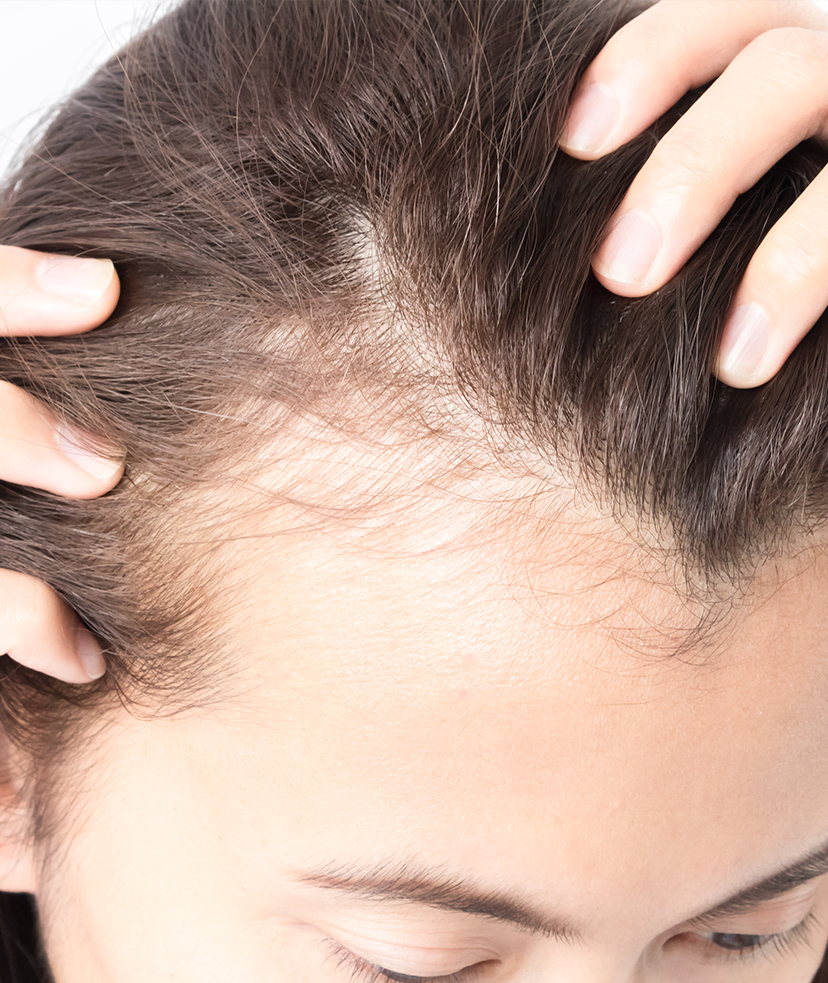Hair loss can be a frustrating and complicated issue to deal with. There are a variety of different types and the causes can range from stress and genetics to underlying issues within the body. Treatments are specific to the type of hair loss you are experiencing and can range from a simple supplement regimen to oral medications. To find the best treatment for you, contact our team here at McLean & Potomac Dermatology.
Androgenetic Alopecia (Genetic)
Androgenetic alopecia is also known as male and female pattern baldness or hereditary hair loss. Everyone loses hair. It is normal to lose about 50-100 hairs every day. However, if you see bald patches or lots of thinning, you may be experiencing alopecia. The most common type of alopecia is a medical condition called hereditary hair loss. About 80 million men and women in the United States have this type.
There are many reasons why people experience this condition. However, if it gradually becomes more noticeable each year, hereditary hair loss is likely.
Symptoms
When men have hereditary hair loss, they often get a receding hairline. Many men see bald patches, especially on the top of the head. Women, on the other hand, tend to keep their hairline. They see noticeably thinning hair. The first sign for many women is a widening part. In rare cases, men see noticeably thinning hair. And in rare cases, women can see a receding hairline or bald patches. The reasons for this are unknown.

Alopecia Areata
Alopecia areata is an autoimmune disease. Autoimmune means that the body’s immune system attacks the body. Alopecia occurs when the immune system attacks the hair follicles (structures that contain the roots of the hair). A person’s genetic makeup, combined with other factors, triggers this form. It can occur at any age; it often begins in childhood. Alopecia is not contagious. It is not due to nerves. This disease most often occurs in otherwise healthy people.
Symptoms
Patchy loss often begins with one or more coin-sized, round, smooth, bare patches where hair once was. Patches left from hair loss can sometimes appear peach-colored. You may first notice this condition when you see clumps of hair on your pillow or in the shower. Thinning and loss occurs mostly on the scalp, but it can involve eyebrows, eyelashes, beards, or any hair-bearing site. Patches vary in size. Alopecia areata also can affect your fingernails and toenails. Sometimes nail changes are the first sign of alopecia areata. Nails can have tiny pinpoint dents (pitting). They also can have white spots or lines, be rough, lose their shine, or become thin and split. Rarely do nails change shape or fall off.
Telogen Effluvium
Telogen effluvium is a form of nonscarring (temporary) hair loss characterized by diffused shedding. This type often occurs noticed suddenly after an individual has experienced stress. Physical stress, or illness, can cause this type, as can emotional stress.
Symptoms
Typically, abrupt diffuse loss is noticed several weeks to months after the incident initiates the biologic program for hair loss. While the most often noticed loss occurs on the scalp, some individuals may also notice it elsewhere on the body. Significant hair shedding usually occurs when shampooing, combing, or gently manipulating the hair. Shedding usually slowly decreases over 6 to 8 months once the cause is no longer present.
Lichen Planopilaris (LPP)
Lichen planopilaris, or scarring alopecia, is a rare inflammatory condition that results in progressive, permanent hair loss. This occurs most often on the scalp. LPP usually affects young adult women, although the age range is wide and can also affect men. Although LPP is rare, it is one of the most common causes of scarring hair loss on the scalp. The cause of LPP is unknown.
Symptoms
LPP typically presents as smooth white patches of scalp hair loss. No follicle openings can be seen in the areas of the loss. At the edges of these patches, scale, and redness may be around each hair follicle. Hairs can be easily pulled out. Common sites of involvement are the scalp’s sides, front, and lower back. Symptoms are often absent but may include itching, pain, tenderness, discomfort, burning
Traction Alopecia
Traction alopecia is hair loss due to tight pulling on the hair, such as frequently wearing your hair in a tight ponytail or braid. It is very common in African American women and those wearing hair weaves.
Symptoms
Tight hairstyles that result in traction alopecia are often uncomfortable or painful. You may have a headache or soreness of the scalp from the tight hairstyle. While your hair is in that particular style, moving your forehead or temples may also be difficult. During the beginning stage of traction alopecia, you may have red bumps or flaking of the scalp. There may also be small, short, broken hairs in this area. Eventually, this will result in a hairline recession or part line with permanent hair loss.
How Do We Address Hair Loss?
McLean & Potomac Dermatology offers several treatment options, including platelet-rich plasma (PRP) injections that use your own platelets to nourish your scalp. These treatments are not hair transplants and don’t require extensive downtime. Get in touch to stall your hair loss and retain your beautiful mane long-term.
Find Hair Loss Treatments in McLean, VA, or Potomac, MD
Hair loss can be caused by genetic or environmental factors (it can even be caused by an underlying disease). If you’ve been shedding a little more than usual, we can help identify the cause of your symptoms. Get in touch with our team at McLean & Potomac Dermatology to explore our treatment options and get the care you deserve.
You can reach us by messaging us through the Klara app on this website or giving us a call at (703) 356-5111.


